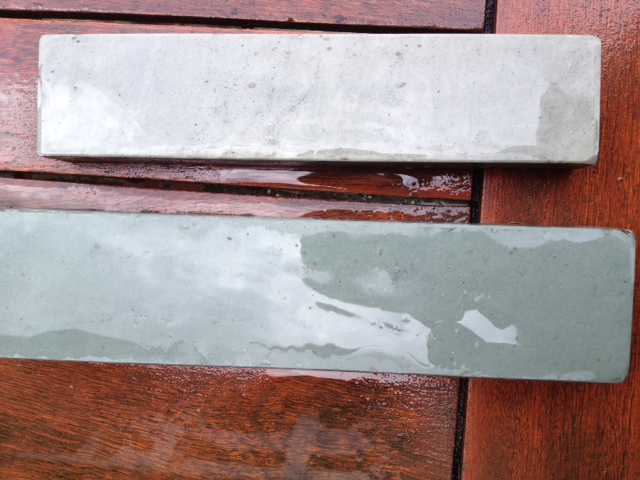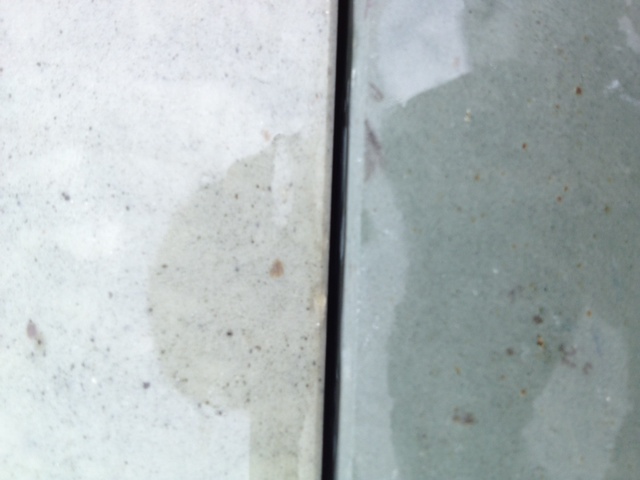Results 11 to 20 of 21
Thread: Scottish green hone stones
-
05-15-2012, 09:58 AM #11

I just thought they were LI's, but they are finer and a darker shade of green. If there was any red on it, I'd think it was a CF.
-
05-15-2012, 12:31 PM #12

Thanks for sharing Scipio, I have a nice LI and a very nice CF in my collection. I have tested other British stones in the past but this one is behaves differently as I am learning. The shave off the stone was expected, more trials are required. I am fastidious when it comes to edges.
I am happy with this stone and the craftsman ship that went into assembling this piece. It’s beautiful. The variances in these stones remind me of the J-nats. I enjoy testing and sampling the Japanese naturals, however they don’t come packaged like this unless you spend thousands.
MIke
-
05-15-2012, 12:51 PM #13

Here is a comparison to my LI. Outside in the rain

They are very similar in hardness and finish, but visually different.


-
The Following User Says Thank You to Scipio For This Useful Post:
MODINE (05-15-2012)
-
05-15-2012, 02:29 PM #14

It rained in London? lol.
MIke
-
05-15-2012, 02:35 PM #15

Unfortunately so

I figured all those green stones were LIs or Greicans or whatever else they are currently being referred to as. 'Chisel stones' perhaps. I do know that they work better with oil.
-
05-20-2012, 03:52 PM #16

Just as a note of interest maybe to some, after testing carbon steel and stainless steel razors this is a fast cutting un-forgiving stone. While it does not look the same, this stone behaves much like the “Special Stones” from Northern France & Germany. More than 24 passes on oil and you are close to destroying the edge. Melts the razors edge to Swiss cheese. This is quite visible at 100X magnification. 12 passes is more than adequate to finish an edge. I have an idea on how this type of stone was probably used. It works well with other natural stones.
-
The Following User Says Thank You to MODINE For This Useful Post:
randydance062449 (05-21-2012)
-
05-22-2012, 11:01 PM #17

Is it a fact that an edge can be destroyed from a fine hone? I'm not sure how can this happen. Supposedly, when it can't get any sharper, you move to the next, finer hone. How is this dulling effect possible?
-
05-23-2012, 12:08 PM #18

Thatís a good question; certain final finishing stones can be aggressive cutters. Others can be less aggressive and slower cutters. When honing a razors edge to its maximum capacity, you reach a threshold limit. At this point the edge with get keener or it will start to deteriorate.
Honing an edge is a destructive action with a constructive purpose. The last 1% of the formula is the most difficult to achieve. When I test a final finishing stones capability, edge destruction is part of the equation. I hope this helps to answer the question.
MIkeLast edited by MODINE; 05-23-2012 at 12:09 PM. Reason: spll
-
05-23-2012, 12:12 PM #19Historically Inquisitive



- Join Date
- Aug 2011
- Location
- Upstate New York
- Posts
- 5,782
- Blog Entries
- 1
Thanked: 4249
-
05-23-2012, 12:20 PM #20

Are you referring on what on knives, chisels is called burr on the edge? Over-honing? I'm sorry, I didn't understand when I first read it, and I was wandering if there is something else that could ruin an otherwise very fine edge. This makes sense. And, I agree, especially for razors, knowing when to move to the next finer hone without overhoning is very useful. Thank you


 4Likes
4Likes LinkBack URL
LinkBack URL About LinkBacks
About LinkBacks







 Reply With Quote
Reply With Quote
